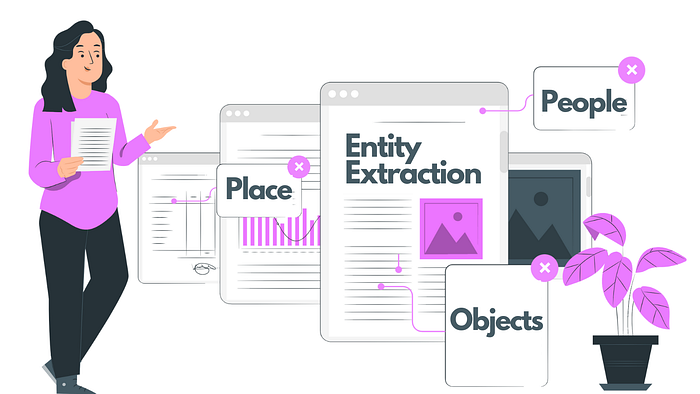Entity Extraction Application and Tools

Entity extraction is a natural language processing (NLP) technique for extracting mentions of entities (people, places, or objects) from a document. This can be done for a variety of reasons, including understanding the context of the content, providing a summary of the document, or building a knowledge base of entities mentioned in the document.
It enables teams to identify relevant information in massive amounts of unstructured text data. However, owing to automated entity extraction, you may have the information you require in a matter of seconds.

Sifting through hundreds of surveys, emails, customer support requests, or product reviews would necessitate the deployment of a technology sorter that would automatically sort the data, saving many hours of work.
Applications of entity extraction
- Online customer reviews can be a fantastic source of information for targeted development. With entity extraction, you may examine consumer feedback to determine what they like and dislike.
- Entity extraction tools aid in automating ticket tagging and routing tickets to the appropriate agent.
- Recommendation systems can detect other products that contain similar entities by automatically identifying entities in a product specification.
- You can easily detect when customers mention your brand or other businesses.
- Using named entity recognition and establishing tags such as names, talents, education, and experience to filter down the list of candidates can make life easier for everyone in the human resources department.
Tools you can use to perform entity extraction
Entity extraction can be performed with a variety of tools, each with its own set of advantages and disadvantages.
1. BytesView
BytesView’s text analysis API is simple to use and can accurately assess user information by analyzing complex structured or unstructured text data.
Using their text analysis solutions, you can easily collect text data from multiple sources and use it to focus on improving your customer support services, employee and customer response solutions, and so on.
2. IBM Watson
IBM Watson is the company’s AI platform of choice. Watson’s Natural Language Understanding API gives developers advanced tools and features for creating deep learning text analysis models.
Watson Natural Language Classifier (for text classification), Watson Tone Analyzer (for emotion analysis), and Watson Personality Insights are all use APIs within the Watson environment (for customer segmentation).
3. Cortical.io
It allows you to search for, extract, and analyze keywords from virtually any unstructured text. Their models can be taught swiftly with vocabulary appropriate to your industry.
4.Monkeylearn
MonkeyLearn is a text analysis program known for its adaptability. Simply create tags and then manually highlight different parts of the text to show which content belongs to which tag.
Over time, the software learns on its own and can process multiple files at the same time It contains a collection of pre-trained models for tasks such as sentiment analysis, keyword extraction, urgency detection, and much more
5. Natural Language API for Google Cloud
Using Google’s machine learning, the Google Cloud Natural Language API helps businesses understand and help advance information in the text. It essentially offers two types of options: a set of pre-trained models for analyzing sentiment, locating entities, and categorizing content, and Cloud Auto ML, a suite for creating custom machine learning models.
Creating your own models is straightforward, and there are numerous guides available to help you navigate the API.
6. Lexalytics
Lexalytics is a text analytics solution that analyses various types of text. Lexalytics can analyze social media comments, surveys, and reviews, as well as any other type of text document. Aside from sentiment analysis, the tool also performs classification, theme extraction, and intention detection, allowing users to see the full context.


Comments
Post a Comment